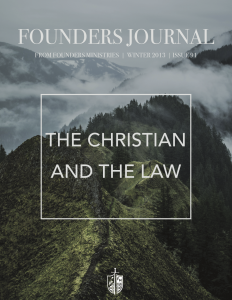Creation’s Coronation and Goal
Chapter 10 from Better Than the Beginning: Creation in Biblical Perspective (Palmdale, CA: Reformed Baptist Academic Press, 2013). Re-printed with permission.
Thus the heavens and the earth were completed, and all their hosts. By the seventh day God completed His work which He had done, and He rested on the seventh day from all His work which He had done. Then God blessed the seventh day and sanctified it, because in it He rested from all His work which God had created and made. (Genesis 2:1-3)1
Introduction
This is a massive subject. The issue of the Sabbath has caused much ink to be spilled in our day as well as in previous days. Sabbath simply means rest. But what does God’s rest mean for God and for us? There is much confusion on this issue due to not understanding the first revelation of the Sabbath as found in Genesis 2:1-3. This confusion, in part, is due to not allowing other parts of the Bible to explain the function of the Creator’s Sabbath. In order to understand the Bible correctly, we have to understand what the Creator’s Sabbath means, not only for us but for God. In order to do that, we have to let the Creator tell us what it means. He does just that in various places in the rest of Scripture.
Every picture tells a story and every person has a story. But there is one Person whose story stands apart from all others and that story is God’s, recorded for us in the Bible. God’s story tells us that He created, what He created in the first place, why He created man and what man’s supposed to do, why there’s so much trouble on the earth, and where history is heading. In the next two chapters, I want to show that understanding the Creator’s Sabbath helps us understand the entire Bible–what it is about, what went wrong, how God’s going about fixing what went wrong, and where history is heading. In order to do that, it is important to understand the Bible’s diversity and unity and its beginning and end.
The Bible’s Diversity
The Bible is a huge book with many diverse parts. We have both an Old and a New Testament. There are thirty-nine books in the Old Testament, written over a period of about 1,500 years by many different authors, in different cultural and religious circumstances from which we live. The New Testament has twenty-seven books, written within the time-frame of one generation, a little over 2,000 years ago. But that generation existed in a world different than ours as well. Add to that the fact that the Bible has different kinds of literature, like narratives that tell stories of ancient events, people, and places, prophecies that tell of things to come, and epistles, which are letters written by apostles to local churches in the first century, and the Bible gives the appearance of being made up of disconnected books, written by various authors who did not know each other over a long period of time with no central point, no plot, no story-line, and no conclusion.
The Bible’s Unity
Those who read and think deeply upon the text of Holy Scripture realize that though it has diverse books and diverse authors and even diverse languages,2 in all its diversity there is a wonderful unity in it. This unity is due to its divine author, who is none other than God Himself.
One of the ways the overall unity of the Bible may be seen is by comparing the beginning of the Bible with its end. I have a book on one of my shelves entitled, The End of the Beginning: Revelation 21-22 and the Old Testament.3 The author, William J. Dumbrell, argues that the end of the Bible is the beginning of the Bible brought to its intended goal. He argues that the end is actually better than the beginning. Another author, T. D. Alexander, says:
As is often the case, a story’s conclusion provides a good guide to the themes and ideas dominant throughout. By resolving an intricate plot that runs throughout a story, a good denouement4 sheds light on the entire story.5
This is true in a good mystery novel or movie. The plot (or riddle or problem to be solved) is revealed early on and is finally solved at the end and then everything in between makes more sense. But suppose you start a movie, then 15 minutes later someone walks in and begins to watch. They will have many questions. Though you might be hooked by then, the person who came late will not understand the plot, or setting, or background of the story. By the middle of the movie you will be putting clues together trying to solve the riddle. The other person will be asking you to either explain the various scenes, start the whole thing over, or they will leave. As well, there is usually a twist or twists in the story that finally ends in an amazing way that far exceeds your initial thoughts. The end ties up the loose ends of the beginning and middle and makes sense of the whole. So it goes with the Bible.
Commenting on the relationship between the beginning and end of the Bible Alexander says:
The very strong links between Genesis 1-3 [the first three chapters of the Bible] and Revelation 20-22 [the last three chapters of the Bible] suggest that these passages frame the entire biblical meta-story.6
A meta-story is the overarching story that all the parts of a book are serving. What are some of those themes that end up being in both the beginning and the end of the Bible? Let us explore a proposed answer to this question.
Seven Observations Tying the End of the Bible with the Beginning of the Bible
In this section, I want to explore some themes that occur at the end of the Bible which find their origin in the beginning of the Bible. This will help us see the big-picture so as not to lose the forest for the trees. It also will set a proper context for understanding the Creator’s Sabbath–what it means for God and us.
The devil, who first appears in Genesis 3, ends up thrown into the lake of fire.
Revelation 20:7-10 says:
When the thousand years are completed, Satan will be released from his prison, and will come out to deceive the nations which are in the four corners of the earth, Gog and Magog, to gather them together for the war; the number of them is like the sand of the seashore. And they came up on the broad plain of the earth and surrounded the camp of the saints and the beloved city, and fire came down from heaven and devoured them. And the devil who deceived them was thrown into the lake of fire and brimstone, where the beast and the false prophet are also; and they will be tormented day and night forever and ever (Revelation. 20:7-10).
The Bible has threads within it that deal with the effects of the devil’s activity, not only in the garden of Eden but afterward as well. There is conflict between the woman’s seed and the devil’s seed throughout–the people of God and the children of the devil.
The first heavens and first earth of Genesis 1:1 become a new heaven and a new earth.
Revelation 21:1 says, “Then I saw a new heaven and a new earth; for the first heaven and the first earth passed away, and there is no longer any sea.” Peter tells us that in this new heaven and earth “ righteousness dwells” (2 Peter 3:13). Remember, God kicked Adam and Even out of the garden because they became unrighteous.
The tree of life, first revealed in Genesis 2, ends up on the new earth.
Describing the eternal state, Revelation 22:2 says, “On either side of the river was the tree of life ” Revelation 22:14 adds, “Blessed are those who wash their robes, so that they may have the right to the tree of life, and may enter by the gates into the city.” The eschatological city, the new earth, contains the tree of life, which first appears in the Bible in Genesis 2:9.
God will dwell among all the citizens of the new earth.
Revelation 21:3 says, “And I heard a loud voice from the throne, saying, ‘Behold, the tabernacle of God is among men, and He will dwell among them, and they shall be His people, and God Himself will be among them.’” God dwelt in the garden with Adam and Eve but they were exiled from that first dwelling place of God among men because of their sin. Then God dwelt in Israel’s tabernacle and temple, then in Jesus Christ, as John tells us in John 1:14, “And the Word became flesh and dwelt among us ” God’s dwelling with men is now experienced by the church, the new temple of God, the new house of God, which is “ a dwelling of God in the Spirit” (Ephesians 2:22). But in the new earth, God will dwell with everyone, not just the church in distinction from the outer world of men. The whole earth will be a special dwelling place of God among men.
There will no longer be any death in the new earth.
Revelation 21:4 says, “ there will no longer be any death.” Death came when sin came way back in Genesis 3. In the new earth, there will no longer be any death.
The new Jerusalem is described with the symbolic language often used of temples.
Here is Revelation 21:10-22.
And he carried me away in the Spirit to a great and high mountain, and showed me the holy city, Jerusalem, coming down out of heaven from God, having the glory of God. Her brilliance was like a very costly stone, as a stone of crystal-clear jasper. It had a great and high wall, with twelve gates, and at the gates twelve angels; and names were written on them, which are the names of the twelve tribes of the sons of Israel. There were three gates on the east and three gates on the north and three gates on the south and three gates on the west. And the wall of the city had twelve foundation stones, and on them were the twelve names of the twelve apostles of the Lamb. The one who spoke with me had a gold measuring rod to measure the city, and its gates and its wall. The city is laid out as a square, and its length is as great as the width; and he measured the city with the rod, fifteen hundred miles; its length and width and height are equal. And he measured its wall, seventy-two yards, according to human measurements, which are also angelic measurements. The material of the wall was jasper; and the city was pure gold, like clear glass. The foundation stones of the city wall were adorned with every kind of precious stone. The first foundation stone was jasper; the second, sapphire; the third, chalcedony; the fourth, emerald; the fifth, sardonyx; the sixth, sardius; the seventh, chrysolite; the eighth, beryl; the ninth, topaz; the tenth, chrysoprase; the eleventh, jacinth; the twelfth, amethyst. And the twelve gates were twelve pearls; each one of the gates was a single pearl. And the street of the city was pure gold, like transparent glass. I saw no temple in it, for the Lord God the Almighty and the Lamb are its temple (Revelation 21:10-22).
Eschatological or new Jerusalem is described as a cubed city of pure gold. Listen to Revelation 21:16-18 again.
The city is laid out as a square, and its length is as great as the width; and he measured the city with the rod, fifteen hundred miles; its length and width and height are equal. And he measured its wall, seventy-two yards, according to human measurements, which are also angelic measurements. The material of the wall was jasper; and the city was pure gold, like clear glass (Revelation 21:16-18).
The only other golden cube in the Bible is the inner sanctuary of Israel’s temple, called the holy of holies, the special dwelling place of God with man. Listen to 1 Kings 6:20, “The inner sanctuary was twenty cubits in length, twenty cubits in width, and twenty cubits in height, and he overlaid it with pure gold.” Also, gold is often linked with the special dwelling place of God among men. Listen to Genesis 2:10-12.
Now a river flowed out of Eden to water the garden; and from there it divided and became four rivers. The name of the first is Pishon; it flows around the whole land of Havilah, where there is gold. The gold of that land is good; the bdellium and the onyx stone are there (Genesis 2:10-12).
It is important to note that in Revelation 22:1 John was shown “a river of the water of life flowing from the throne of God and from the Lamb.” The entire new Jerusalem appears to be an expanded holy of holies–the special dwelling place of God among men.
One more observation on rivers in light of Revelation 22:1 may help. Rivers flow downhill. Since this is so, the rivers of Eden (Genesis 2:10-12) flowed downhill, which puts it uphill or upon a mountain. Now listen to Revelation 21:10-11a and 22:1, “And he carried me away in the Spirit to a great and high mountain, and showed me the holy city, Jerusalem, coming down out of heaven from God, having the glory of God” and “Then he showed me a river of the water of life ” Do you see it? The new Jerusalem is pictured as having a river flowing out of it and connected to a high mountain. The special dwelling place of God among men in the end of the Bible depicts a river of life and a high mountain. Where did this type of language and these concepts come from? From the Bible itself. The entry for “Mountain” in the Dictionary of Biblical Imagery reads:
Almost from the beginning of the Bible, mountains are sites of transcendent spiritual experiences, encounters with God or appearances by God. Ezekiel 28:13-15 places the *Garden of Eden on a mountain. *Abraham shows his willingness to sacrifice Isaac and then encounters God on a mountain (Genesis 22:1-14). God appears to Moses and speaks from the *burning bush on “Horeb the mountain of God” (Exodus 3:1-2 NRSV), and he encounters Elijah on the same site (1 Kings 19:8-18). Most impressive of all is the experience of the Israelites at Mt. *Sinai (Exodus 19), which *Moses ascends in a *cloud to meet God.
A similar picture emerges from the NT, where Jesus is associated with mountains. Jesus resorted to mountains to be alone (John 6:15), to *pray (Matthew 14:23; Luke 6:12) and to teach His listeners (Matthew 5:1; Mark 3:13). It was on a mountain that Jesus refuted Satan’s temptation (Matthew 4:8; Luke 4:5). He was also transfigured on a mountain (Matthew 17:1-8; Mark 9:2-8; Luke 9:28-36), and he ascended into heaven from the Mount of Olives (Acts 1:10-12).7
Jesus also designated a mountain in Galilee from which He gave the Great Commission to the eleven in Matthew 28:16, “But the eleven disciples proceeded to Galilee, to the mountain which Jesus had designated.” Jesus is both the tabernacle of God among men (John 1:14) and a temple (John 2:19-22) who builds the new temple (1 Corinthians 3:16-17; Ephesians 2:19-22), His body, the church. Hebrews 12:18-24 contrasts Mount Sinai and Mount Zion in the context of the transition from the Old Covenant to the New Covenant. God’s people have gone from one mountain to another. Surely these mountains are symbols of the Old Covenant and the New Covenant and have their foundation in the first mountain-temple, the garden of Eden.
The curse that was inflicted in Genesis 3 due to Adam’s sin is no more.
Revelation 22:3 says, “There will no longer be any curse; and the throne of God and of the Lamb will be in it, and His bond-servants will serve Him.” Due to not serving God, the curse came upon man and the earth. In the eternal state, “there will no longer be any curse.”
Conclusion
The Bible ends “[w]ith [a] remarkable vision of God coming to dwell with humanity on a new earth.”8 But the Bible started with God in the midst of His people in the garden of Eden, on a mountain, with precious stones present, with water flowing out of it, and in a context where Adam, the first prophet-priest-king, was supposed to subdue the earth and fill it with other image-bearers who were like him (i.e., sinless sons of God). What happened? Sin happened.
How Does all this Relate to the Creator’s Sabbath?
The connections between the end of the Bible and its beginning are very instructive for our study at this point.
The connections between the end of the Bible and its beginning set the broader, big-picture context in order that the details might be easier to understand.
When we know the end of the story, we may know better the beginning and everything in between. For example, at the end of the Bible, the entire new earth is sacred space. God dwells with all those in that place. In the beginning of the Bible, the sacred space was limited to the garden of Eden. In the middle of the Bible we see altars, a tabernacle, Israel’s temple, Christ Himself, and then the church as sacred space–where God dwells with man in a special, unique way. All of these things–the garden of Eden, altars, Israel’s tabernacle and temple, Christ and His church–point forward. They are symbolic of God’s special dwelling among men on the earth but also mini-glimpses of the future. One day the whole earth will be sacred space where God dwells with men. Stephen G. Dempster says of the Old Testament what is true of the entire Bible, “The goal of the canon is clearly the great house of God, which is as inclusive as the globe.”9 What was instituted in the garden and spoiled by sin ends up brought to completion by our Lord Jesus Christ.
The connections between the end of the Bible and its beginning put the Creator’s Sabbath in the context of completed temple-building.
We will discuss this further in the next chapter, but for now remember that temples are where God dwells on earth among men. The first temple was the garden of Eden, the first high mountain of the earth, where God dwelled with Adam and Eve. The Creator’s Sabbath comes after He made the earth; it comes after He completed the crafting of His temple.
The connections between the end of the Bible and its beginning instruct us that the Bible goes from what God intended in the beginning, which was not accomplished by the first Adam, to what God Himself accomplishes through the last Adam, our Lord Jesus Christ.
In other words, the end is better than the beginning. The Bible goes from old creation to new creation via redemption. It goes from a good creation made bad by Adam’s sin to a new, perfected creation made so by Christ’s obedience.
The connections between the end of the Bible and its beginning help us understand the gospel.
God takes it upon Himself to dwell among men as the man, Christ Jesus. He came to be the hero of redemption, to do what Adam failed to do, to bring many sons to glory through sinless obedience. Because of sin, the last Adam, the Lord Jesus Christ, came to die for the forgiveness of our sins and create a seed, or spiritual children, who one day will fill the new earth, and enjoy inviolable communion with God. What Adam brought upon us all (i.e., guilt), Christ absolves and what Adam failed to do, Christ does (i.e., He brings many sons to glory through obedience). This is the gospel.
1 Bible references are from the NASB.
2 The Old Testament was written in Hebrew and the New Testament in Greek.
3 William J. Dumbrell, The End of the Beginning: Revelation 21-22 and the Old Testament (Eugene, OR: Wipf and Stock Publishers, 2001; previously published by Baker Book House, 1985).
4 A denouement is the final resolution of a plot, as in a drama or novel, a solution, or the end of a story that ties together its various parts.
5 T. Desmond Alexander, From Eden to the New Jerusalem: An Introduction to Biblical Theology (Grand Rapids, MI: Kregel Academic & Professional, 2008), 10.
6 Alexander, From Eden to the New Jerusalem, 10.
7 “Mountain” in Leland Ryken, James C. Wilhoit, Tremper Longman III, Editors, Dictionary of Biblical Imagery (Downers Grove, IL: InterVarstiy Press, 1998), 573.
8 Alexander, From Eden to the New Jerusalem, 14.
9 Stephen G. Dempster, Dominion and Dynasty: A Biblical Theology of the Hebrew Bible (Downers Grove, IL: InterVarsity Press, 2003, reprinted 2006), 227.























